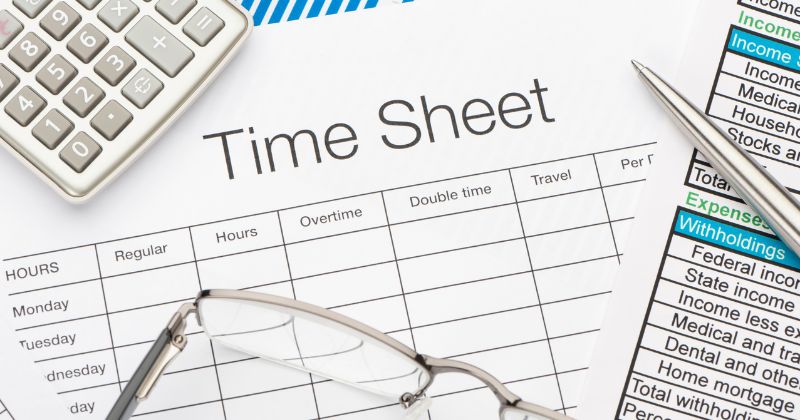Time recording is a not entirely unproblematic issue for any cleaning company that employs staff. Why is that the case? The majority of people employed in commercial cleaning work part-time. In this case, it is therefore not only necessary to measure how much working time was spent on a particular customer, but also how much the cleaning specialist worked in general. However, this is not so easy: there are often different views regarding planned hours and actual hours, regarding working time models and contracted working hours, regarding overtime, extra hours and time off in lieu or simply regarding the break times to be observed. Under these conditions, it is sometimes difficult to quickly forward the correct timesheet – signed by the employer and employee – to the accounting department.
From time to time, records are even lost or not made at all. At the end of the month, this can lead to disputes in the worst case. In many cases, this also leads to dissatisfied employees. Problems that could be avoided and have a negative impact on staff turnover in the company.
It is therefore all the more important to find a way to record the hours worked in a cleaning company correctly, comprehensibly and simply. We have dealt with this topic for you in this article.
Types of time recording in commercial cleaning
As is so often the case, there are several ways to reach your destination. We provide you with various solutions. You decide.
1. Time sheet
The analog method for recording the hours worked by your employees is the timesheet. They are filled out by the employees and sent to the HR department at the end of the month. Time sheet templates can often be found online – or you can create your own version in Excel or Word. By law, a time sheet must contain the following information:
- Name and personnel number
- Date
- Start of work
- End of work
- Total working time
- Breaks
Each employee signs the slip at the end of the month and the matter should be settled.
Especially if you run a relatively small cleaning company, timesheets can be your ideal solution. BUT also bear in mind that this type of time recording is relatively error-prone:
- Timesheets must be checked every month by the facility management (and subsequently by the HR department). This non-automated control is extremely laborious and, depending on the number of employees, time-consuming – but it is absolutely necessary!
- As timesheets have to be filled out individually by each person and then checked by the site manager and the HR department, there is a high level of manual effort on the part of employers AND employees.
- If your employees forget to hand in their timesheets on time, this creates additional administrative work.
- Timesheets must meet legal requirements in order not to be objected to by the legislator. (see bullet points above)
- Time sheets that are not legible can lead to incorrect records.
As you can see, if you decide to use timesheets to record your working hours, you should think about it carefully. Of course, it is one of the most accessible options and requires little digital knowledge – both on your part and on the part of your employees.

2. Digital standalone time recording systems
Digital time recording systems enable users to record their time online. Desktop-based time recording systems are installed on the computer and usually require a login with a user name and password. Mobile phone-based time recording systems enable your employees to record their time via their cell phone. Some systems require an app, others can be used without a special download.
App solutions in particular, which are intuitive to use, make time recording in a building cleaning company much easier. Your employees can clock in by clicking a button as soon as they have reached the object. When they leave it again, the same principle is applied. In this way, all time recording data is bundled in one place – namely in the software. At the end of the month, the HR team can access it automatically and does not have to add up the working hours manually.
Some software solutions for the cleaning industry also offer a GPS tracking function. Wowflow is no exception. As a manager, you can specify that “GPS is required for work“. In this case, the cleaning specialist can only start an activity (via button) if they are actually on site. This gives you additional security: your employees can’t cheat when recording their hours.
The wowflow feature ” Application period” also falls into a similar area. Here you can define how long a team member should need for a certain task. If this period is exceeded, you will be notified. This function is not only for you to check, but above all for the protection of the employee and as argumentation material for customers.
Of course, digital time recording also has a few disadvantages :
- Your team has to come up with a new solution. This is not always easy, especially when you are working with older people.
- Depending on the software, operating difficulties may occur. If the app is not designed with the user in mind, comprehensive training may be required.
The recorded data must be checked and errors corrected. This is the only way that the correct timesheet can be signed by the respective team member. In some companies that use standalone time recording without a connection to the orders, admin employees have to check the clocked times for days and correct them if necessary. Only then can the time sheet be signed.
3. Fully integrated time recording
In the case of fully integrated time recording – as offered by Wowflow – your employees receive weekly schedules and work assignments digitally. You then only confirm the performance of the activities. It is therefore not just a work recording software, but also an information and communication tool – both for team members and management. In this case, the work recording happens “incidentally” and automatically, so to speak. It is in harmony with the daily work. At the end of the month, the property management:
- quickly and easily compare which work has been completed according to plan and within the scheduled time.
- determine which work was associated with additional expense. In these cases, the customer may be charged subsequently or a meeting with an employee may be scheduled.
- determine on which days the team member was on vacation or sick leave.
If the facility management has access to all this information on the last day of the month, they can create the timesheet within a few minutes and send it to the HR department. The prerequisite for this is a fully integrated order and reporting system. Numerous companies already use this type of hours recording – it is a by-product of day-to-day business, so to speak: fast, uncomplicated and accurate.
Ultimately, you have to decide for yourself whether you choose the analog, digital or fully integrated option for recording hours in your cleaning company. However, as digitalization is advancing inexorably in all sectors – and rightly so – we clearly recommend a fully integrated solution. This will not only save you time, but also money. Fast and efficient communication with employees and customers is a MUST nowadays in order to survive against tough competition.
If you have any further questions: You know where to get in touch.



